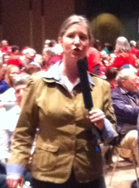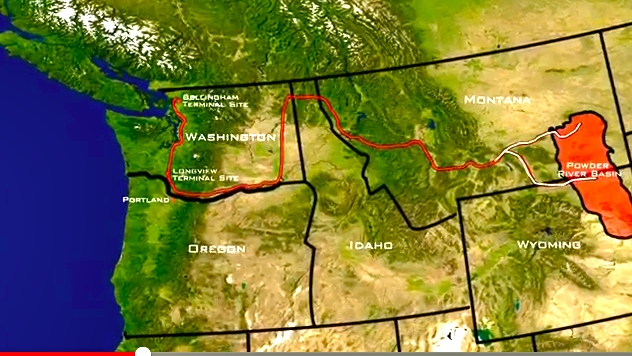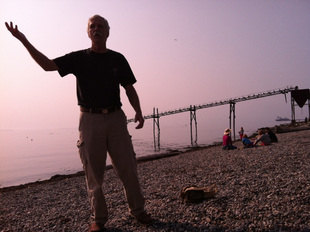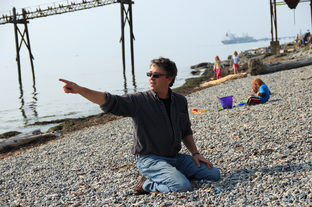Reporting Live: Public speaks on coal port proposalClick on the image at right to launch UStream video filmed by the Center for New Media.
Then scroll/fast forward the video to 32:10 for my live reporting from the Seattle EIS Scoping Meeting, Room 1 at the Washington State Convention Center, broadcast on Dec. 13, 2012. [Unfortunately, there may be a brief advertisement to start. Apologies in advance.] |
Window of Opportunity: 120-Day Scoping Period for
Gateway Pacific Terminal ends Jan. 21, 2013
by Jennifer Karchmer || the Transparency Report*
Sept. 24, 2012
|
Editor's Note: Independent journalist Jennifer Karchmer is covering the Gateway Pacific Terminal proposal with a focus on the public process. She writes regularly about freedom of the press and First Amendment issues.
BELLINGHAM, Wash. Whether you’re handing out “No Coal Trains” buttons at the Co-op or you’re cheering the possibility of new jobs to the region, you will want to know the much anticipated “scoping” period for the Gateway Pacific Terminal (GPT) proposal begins today, Sept. 24, 2012 – that’s the 120-day window open to public comments specifically about environmental concerns. Until Jan. 21, 2013, you can submit letters (email, typed, handwritten) and speak in person explaining what you think needs to be studied – air, water, land, marine life, health and quality of life issues– before the project moves into the next phase. In a nutshell, SSA Marine is planning to cater to overseas markets, particularly in Asia, by building the GPT in Cherry Point, WA, to export dry bulk resources like grain, potash and coal. Controversy lies around the effects of coal being transported. The company says the project will create long-term jobs and boost the economy with much needed tax revenue. Opponents say coal dust, increased noise and traffic are environmental hazards and the negative effects on marine life far outweigh perceived economic benefits. The proposal is quite involved and complicated and, in fact, folks on all sides of the issue are speaking out via social media, protests, informational meetings and other means to voice their stance. The scoping period, however, is designed to garner comments specifically on environmental concerns and mitigation. It’s not a time for hashing out the pros and cons of the project, according to Jeannie Summerhays, Regional Director with the Washington State Dept. of Ecology. The public will have an opportunity for that later in the process. So if you want to participate and get your concerns on the record and documented, the following information will help address some questions. QYMLWA (Questions You Most Likely Will Ask):
11. Where can I speak? You can provide oral comments at any of the public meetings scheduled in the region. The first meeting is scheduled for Sat. Oct. 27, beginning at 11 a.m. at Squalicum High School, 3773 East McLeod Road, Bellingham, Washington 98226-7728. Click here for the entire public comments from the meeting held in Seattle, Thursday, Dec. 13. 12. Who is available to contact if I have a question on any of this? Mr. Randel Perry with the U.S. Army Corps of Engineers, email: [email protected], by regular mail (above) or by phone: (360) 734-3156. (Note spelling of first name is “Randel.”) Sources for this article EIS for GPT/Custer Spur: http://eisgatewaypacificwa.gov/ US Army Corps of Engineers Announcement for Intent to Prepare EIS: https://www.federalregister.gov/articles/2012/09/21/2012-23301/notice-of-intent-to-prepare-a-joint-environmental-impact-statement-eis-for-the-gateway-pacific Approximate timeline: http://www.ecy.wa.gov/geographic/gatewaypacific/Spring_We_are_here.jpg Resources to help craft scoping comments: http://protectwhatcom.org/eis-scoping/ [scroll down] How to draft a scoping comment: http://protectwhatcom.files.wordpress.com/2012/01/scopingtips2.pdf Sample scoping letter: http://protectwhatcom.files.wordpress.com/2012/01/samplecomment1.pdf Read about scoping process: http://protectwhatcom.org/eis-scoping/ *the Transparency Report is dedicated to covering stories that involve government accountability, public responsibility, freedom of speech, freedom of expression, transparency and the role of journalism in a democratic society. Jennifer Karchmer serves as Editor. Copyright Jennifer Karchmer 2012. For reprinting, publishing and linking, contact Jennifer with an email to: [email protected]. |
“Decisions are made by those who show up”
(bumper sticker, source unattributed) 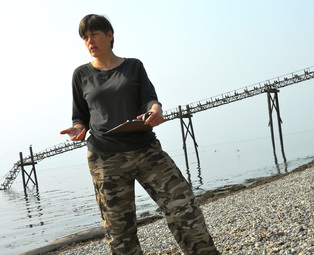
Wendy Steffensen, lead scientist at RE Sources for Sustainable Communities, gives a talk on the history of Cherry Point on Sept. 23. She's seen here speaking at the GPT proposed site where 25 people gathered for an informational community meeting. Half of the group biked from downtown Bellingham to the site (40 miles r/t). Photo: Jennifer Karchmer.
|
|
Jeannie Summerhays with the Washington State Dept. of Ecology gave a public presentation on March 20, 2012 at Bellingham High School to inform the community about how an Environmental Impact Statement (EIS) is created. Video provided by CoalFilm
|
What is scoping? Info, background & definitions
by Jennifer Karchmer || the Transparency Report* Sept. 24, 2012 BELLINGHAM, Wash. – Are you trying to sift through the alphabet soup (NEPA/SEPA) that makes up the Gateway Pacific Terminal (GPT) proposal? Here is an outline highlighting some valuable resources put out by the Wash. State Dept. of Ecology, one of the lead agencies on the GPT project. You’ll learn what NEPA/SEPA (say "knee-puh, see-puh") means, what is scoping and why your comments are important at this time. Go to YouTube and locate: “GPT Environmental Impact Statement, Parts 1-5” posted by CoalFilm, a group of Bellingham-based filmmakers volunteering their time to create a documentary of the GPT proposal. In her 40-minute presentation (five separate videos), Washington State Dept. of Ecology Regional Director Jeannie Summerhays provides a clear overview of the EIS, the scoping process, the geographic location of the port, public input, how to comment, the agencies involved and expected timelines. Throughout the videos, Summerhays refers to this PowerPoint. If you’re unable to watch the entire video, I have viewed it several times and provide (below) some notes and highlights for further inquiry. Part 1: GPT Environmental Impact Statement (runtime 5:08): http://www.youtube.com/watch?v=yppMkN2m6ms basic overview, common terms, explanation of NEPA/SEPA. Highlight (go to 3:13): explains how important the public is to the NEPA/SEPA procedures. Part 2: GPT Environmental Impact Statement (runtime 6:27): http://www.youtube.com/watch?feature=endscreen&v=0eXWm-LnbDQ&NR=1 geography of the proposal, acres being developed, good visuals and explanation. Highlight (go to 3:36): who are the lead agencies, how this is a unique situation. Part 3: GPT Environmental Impact Statement (runtime 12:50): http://www.youtube.com/watch?v=ftcNsdkTfhA&feature=plcp how NEPA & SEPA work, more good visuals. Highlight (go to 6:27): steps required in NEPA/SEPA process. Highlight (go to 10:55): consultant’s role in preparing EIS, who pays, impartiality. Part 4: GPT Environmental Impact Statement (runtime 7:37): http://www.youtube.com/watch?v=1fuIUzTfBPI&feature=plcp what is scoping? public comment and transparency in the process. Highlight (go to 1:29): public is invited to provide input. Highlight (go to 6:28): details of scoping meetings and comments. Part 5: GPT Environmental Impact Statement (runtime 6:54): http://www.youtube.com/watch?v=OQ6SwC-1_4o&feature=relmfu scoping process and public comments. Highlight (go to 1:22): explains set sequence of steps that must stay in order, individuals and groups must resubmit comments even if sent in earlier. Highlight (go to 3:12): how to craft your public comments. Copyright Jennifer Karchmer 2012. For reprinting, publishing and linking, contact Jennifer at [email protected]. |
